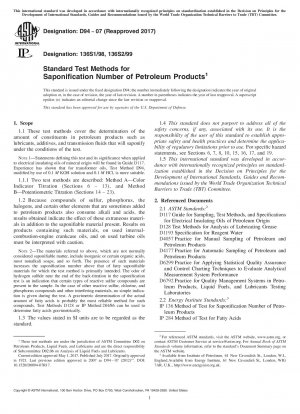ASTM D94-07(2017)
Standard Test Methods for Saponification Number of Petroleum Products
- Standard No.
- ASTM D94-07(2017)
- Release Date
- 2007
- Published By
- American Society for Testing and Materials (ASTM)
- Latest
- ASTM D94-07(2017)
- Scope
-
5.1 Petroleum products can contain additives that react with alkali to form metal soaps. Fats are examples of such additives. Also, certain used engine oils, especially from turbine or internal combustion engines, can contain chemicals that will similarly react with alkali. The saponification number expresses the amount of base that will react with 18201;g of sample when heated in a specific manner. This then gives an estimation of the amount of acid present in the sample, that is, any free acid originally present plus any combined (for example, in esters) that have been converted to metal soaps during the heating procedure.
5.2 Saponification numbers are also used in setting product specifications for lubricants and additives.
1.1 These test methods cover the determination of the amount of constituents in petroleum products such as lubricants, additives, and transmission fluids that will saponify under the conditions of the test.
Note 1: Statements defining this test and its significance when applied to electrical insulating oils of mineral origin will be found in Guide D117. Experience has shown that for transformer oils, Test Method D94, modified by use of 0.1 M KOH solution and 0.1 M HCl, is more suitable.
1.1.1 Two test methods are described: Method A—Color Indicator Titration (Sections 6 – 13), and Method B—Potentiometric Titration (Sections 14 – 23).
1.2 Because compounds of sulfur, phosphorus, the halogens, and certain other elements that are sometimes added to petroleum products also consume alkali and acids, the results obtained indicate the effect of these extraneous materials in addition to the saponifiable material present. Results on products containing such materials, on used internal-combustion-engine crankcase oils, and on used turbine oils must be interpreted with caution.
Note 2: The materials referred to above, which are not normally considered saponifiable matter, include inorganic or certain organic acids, most nonalkali soaps, and so forth. The presence of such materials increases the saponification number above that of fatty saponifiable materials for which the test method is primarily intended. The odor of hydrogen sulfide near the end of the back-titration in the saponification test is an ind......
ASTM D94-07(2017) Referenced Document
- ASTM D117 Standard Guide for Sampling, Test Methods, Specifications, and Guide for Electrical Insulating Oils of Petroleum Origin
- ASTM D1193 Standard Specification for Reagent Water
- ASTM D128 Standard Test Methods for Analysis of Lubricating Grease
- ASTM D4057 Standard Practice for Manual Sampling of Petroleum and Petroleum Products
- ASTM D4177 Standard Practice for Automatic Sampling of Petroleum and Petroleum Products
- ASTM D6299 Standard Practice for Applying Statistical Quality Assurance and Control Charting Techniques to Evaluate Analytical Measurement System Performance
- ASTM D6792 Standard Practice for Quality Management Systems in Petroleum Products, Liquid Fuels, and Lubricants Testing Laboratories
ASTM D94-07(2017) history
- 2007 ASTM D94-07(2017) Standard Test Methods for Saponification Number of Petroleum Products
- 2007 ASTM D94-07(2012)e1 Standard Test Methods for Saponification Number of Petroleum Products
- 2007 ASTM D94-07(2012) Standard Test Methods for Saponification Number of Petroleum Products
- 2007 ASTM D94-07 Standard Test Methods for Saponification Number of Petroleum Products
- 2002 ASTM D94-02 Standard Test Methods for Saponification Number of Petroleum Products
- 2000 ASTM D94-00 Standard Test Methods for Saponification Number of Petroleum Products

Copyright ©2024 All Rights Reserved